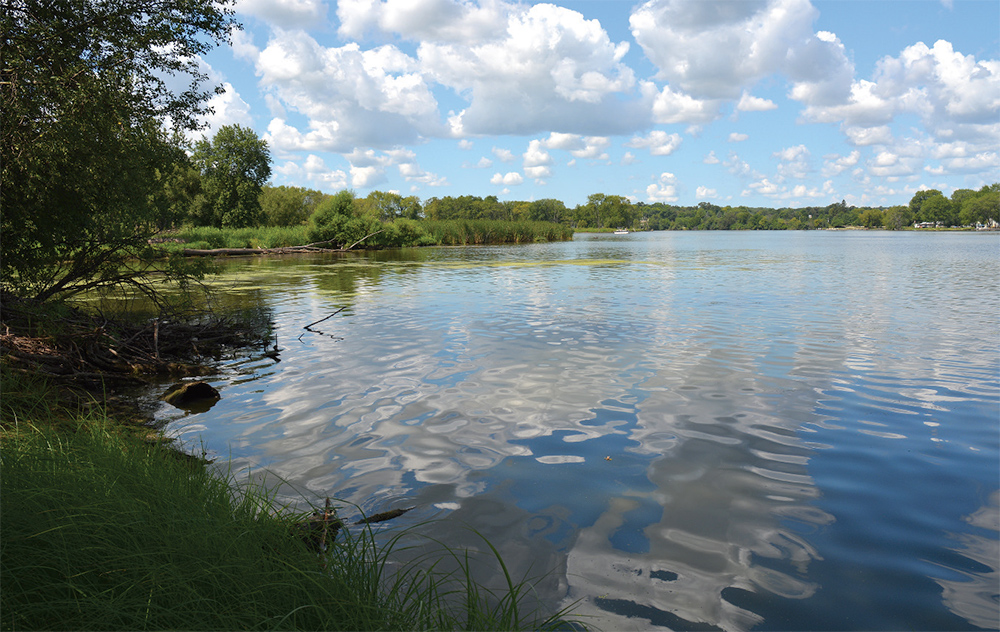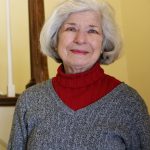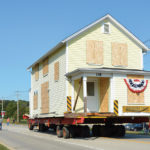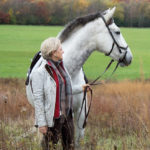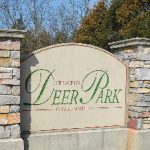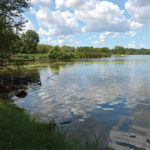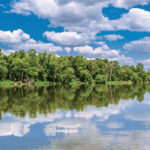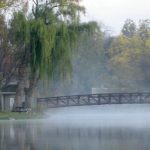The year is 1834, and Joseph Flint, his son Amos, and his sister Mrs. Grace Flint, with the Vincent Freeman family, have come cross-country from the East by horse-drawn wagon to a point in southwestern Lake County, still part of Cook County. They have encamped in a remote location where a winding creek flows into the Fox River. By what route they have chosen this point is unknown. The first known Government Survey map from 1840 records prairie land and ample stands of timber. Grassy Lake was marked then as Cedar Lake.
Of earlier histories of Lake County, the one edited by the Honorable Charles H. Partridge published in 1902, best takes our imagination back to that time of first settlement on land that, 186 years later, would be the thriving Village of Lake Barrington. Partridge wrote:
“Joseph Flint located a claim in Cuba Township, probably in 1834, which was occupied by his bachelor son, Amos Flint, who died in 1837 or 1838. The log house, which was jointly occupied by an aunt, Mrs. Grace Flint and V.H. Freeman and family, burned during their first winter, leaving them in a pitiable condition. Timber was plentiful, however, and little time elapsed before a temporary shelter replaced the burned structure. Flint Creek in Cuba still bears the name of the pioneer of that township. Joseph Flint is understood to have returned east immediately after locating the claim.”
In 1837, McHenry County was created out of Cook County in northeastern Illinois, and by 1839 Lake County was divided off from McHenry, thus giving the new county strategic shoreline along Lake Michigan.
Frances Kelsey
Those first years were lonely ones for the Flint and Freeman families; few records exist until 1840 when the first Census was taken for this territory. There were some travelers on the river, and a Post Office was established in 1839 at the home of Vincent Freeman. The following year it was transferred to a neighbor, John Sears. A letter written in 1842 by Francis Kelsey is one of the most eloquent extant of a journey across the Plains to find a place of settlement. He was a veteran of the War of 1812.
In August of 1842, Kelsey had set out from Shelby County, New York, by horse-drawn wagon. They crossed Ohio, followed the southern route through Michigan and on to Chicago. There had been accident and illness along the way; his mother had died of, interpreted from the letter, as “the bilious” somewhere in Michigan. From Chicago, the family trekked to Janesville and then south to Elgin. There, a friend, Lyman Clifford, commended them to Lake County, and here close to the river, the Kelseys found land that was “just right good”.
They put down their roots between the Fox River and the road that bears their name to this day. Their descendants count into the seventh generation here; in farming, building, and public service. Current family members provide a direct link to them, known through the letter to have been Wealthy, Diantha, and Defores. The headstones of Francis, Wealthy, Defores, Nancy, and Philetus are in White Memorial Cemetery on Cuba Road. Sixteen Kelsey family members are buried in Evergreen Cemetery in Barrington.
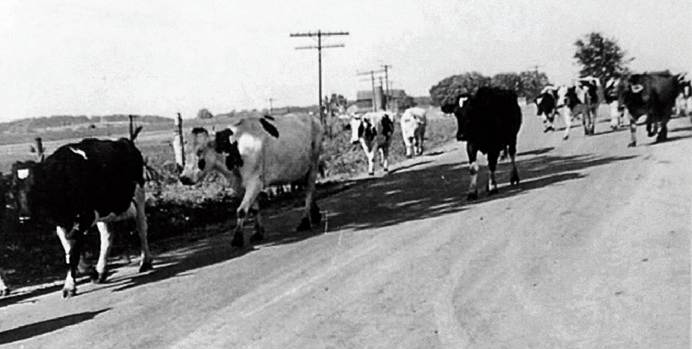
McGraw’s cows on Kelsey Road.
A Name of Exotic Origin
After the Government survey of 1840 and opening of the official land sales office in Chicago that year, purchase claims began east of the Fox River and along the winding Flint Creek. When in 1850 State law called for the naming of Townships and the organization of their local governments, settlers of Township 43 North, Range 9 east of the 3rd Principal Meridian chose Troy, from the vicinity of which, in New York State, many of them had come. But this name had already been claimed in Madison County, Illinois, and could not be duplicated elsewhere in the state. By what inspiration Lewis Bute, newly named a Commissioners of Highways, thought of the expedition by Spanish refugees and southerners to free the island of Cuba from Spanish rule we can only conjecture. His submission of the name “Cuba” to the Commissioners in Lake County was accepted, for future generations to speculate about its exotic origin.
The First Town Meeting
The first Town Meeting was held on the first Tuesday of April 1850. Those elected to the Town board, came as they do today, from all parts of the township. In 1850, from the area that is now Lake Barrington, they included Moderator John J. Bullock, Assessor Jacob McGilvra, and Overseer of the Poor, Francis Kelsey. They watched out for their neighbors as they cut timber for their cabins, tilled their fields with oxen or horse-drawn ploughs, and took their goods to market down river to Algonquin, Dundee, and Elgin, towns in their infancy, and to Des Plaines or even Chicago. In that 1842 letter, Francis Kelsey wrote “I went last week to Chicago and Sylvester Salin went with me. I drove forty bushels of wheat and got eight four cents per bushel. It is thirty two miles…..gone one day and back the next.”
After the vicissitudes of that first winter, the Flints and the Freemans rebuilt a dwelling and soon Vincent Freeman established a sawmill on Flint Creek in the vicinity of the present Lake Barrington Village Hall. His partner in this enterprise was Edward Densmore, who obtained large acreage between the creek and the river, including where the Flint cabin had been located. Their business flourished as new settlers came into the area and built their cabins from the available timber. With plentiful game and fishing they were well provisioned, and as they gradually broke the prairie and raised grain, they existed off the land with some to spare for trading.
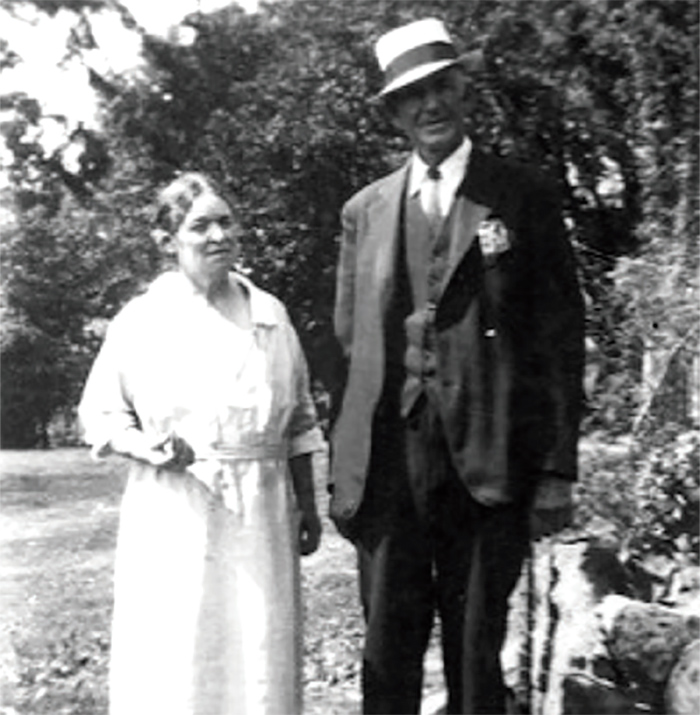
Farmers Lizzie and James McGraw.
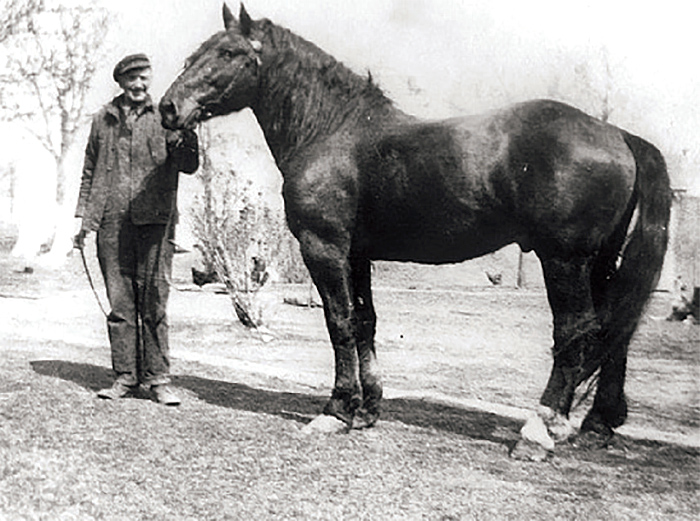
A draft horse at McGraw’s farm.
The Railroad and Cuba Station
Their prospects changed in 1854 when the Illinois and Fond du Lac Railway, soon acquired by the Chicago and Northwestern Railway was extended, first founding the Village of Barrington Station at the Lake-Cook County crossroads and then northwest to Fox River Grove and Cary. A platform was built east of where the track intersects with Kelsey and Plum Tree Roads. Cuba Station became important for Freeman and Densmore as their mill supplied sawn lumber to fuel the locomotives. Later, the platform became essential to the local economy as the dairy farmers took their milk cans to the early morning Chicago train and returned to retrieve their empty cans in the evening. They navigated trails that were alternately dry and dusty, or rutted and muddy, or almost impassable from blizzards and ice storms. At peak production, the farmers hauled nearly 400 eight-gallon milk cans to the Cuba Platform.
The 1861 Plat Map shows the western side of Cuba Township well settled, with the original Yankees and a few Irish and Germans. All brought their varied backgrounds and skills to their new homes and for some, their new country. According to law that required one 16th of each section to be given for a school, basic learning was provided for these isolated children. Two of those schoolhouses remain in Lake Barrington; the Kelsey School on Route 22, now home of the Smart Farm, and the Flint Creek School, twice rebuilt, at Kelsey and Miller Roads, a residence.
The Krause General Store
Later in the 19th century a German farmer, Louis Langenheim, bought about 90 acres surrounding Cuba Station, which for a while took his name. Two of the oldest remaining buildings facing the tracks were a blacksmith shop and a saloon. Langenheim sold ¾ of an acre to Conrad Krause close to where the Kelsey Road House is now. He built a general merchandise store there, and after a brief unsuccessful venture by Charles Lederle bought it back. On April 26, 1892 a Post Office was established in the store and designated as Cuba Station. First Lederle and then Krause were Postmasters. In 1894, the designation was discontinued. But Krause’s general store remained a center of trade, news, and gossip well into the 20th century. Conrad Krause died in 1937 and his family sold the store a year later. Mrs. Charlotte Pritz then opened the Little Cuba Tavern there. She sold the property to Reggie Sexton, who ran a sandwich shop there for several years.
Barn Raising and Beer Joints
In the early 20th century over 400 acres was assembled by James McGraw from several earlier farmers. Known as Ol’ Man McGraw he was a hard taskmaster. He raised grain and herds of dairy cattle. He cemented the predominance then, of this area of Cuba Township as rural, owner farmed country, with hardy, down-to-earth neighbors who valued their independence, and when times were hard, saw each other through floods, drought, blizzards, and the Great Depression.
In 1969, Mrs. Frank Kirby, Conrad Krause’s daughter, drew on youthful memories in an interview with Eugene (Gene) Siskel of the Chicago Tribune. “On rainy days you’d find every farmer in Charlie Hall’s General Store. During the spring we’d leave eggs for credit, got 10 cents a dozen-and when fall came we’d buy our overalls with the credit.” She recalled the good times when neighbors joined to strip and tie quilts. “My father was a carpenter and we’d all get together for barn raisings. After work was done there would be a washtub full of sandwiches and cakes. We’d get a barrel of beer and there’d be dancing on the new barn floor.”
The civic, social, economic, and legal affairs of Cuba Township were well covered by the Barrington Review, which began publishing in 1889. Issues through to 1939 are online at the Barrington Area Library and make informative reading about town and country. Fires, robberies, farm accidents, and vehicle accidents were frequent. During Prohibition years from 1920 to 1933, it was not unusual to see a report that the Sheriff had busted an illegal still out in the countryside!
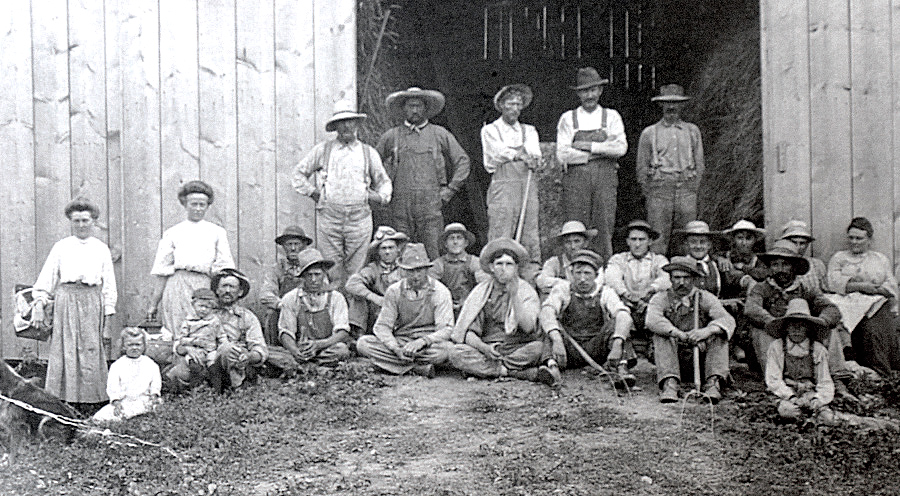
Migrant workers at a farm in Cuba Township.
A Gentleman’s Farming Destination
Except around Biltmore, Cuba Township’s character changed little when the great land rush for farming estates began in the 1920s. The era was documented in an article published in the Chicago Sunday Tribune of May 23, 1937, with the headline “Barrington District Proves Lure to Farm Minded Dwellers of Chicago and Suburbs”, and contained a list of over 120 farm properties that had been acquired for country residences and weekend farms during the past decade. An astonishing 14,000 acres had changed hands in the previous four years alone.
Significant for the future of Lake Barrington, the article noted “John Roberts of Roberts and Oakes packers has a year-round residence costing more than $100,000 on his 500-acre estate north of Tower Lake. Max Hurd, vice-president of the Link Belt Company has a 315-acre farm on the Fox River. G.C. Criswell, candy manufacturer, operates a year-round farm of 425 acres completely surrounding Indian Lake. Others noted were Maurice Karker, President of the Jewel Tea Company with 225 acres just south of Route 22, and Isabelle Bates with 225 acres, later sold to the Quaker Oats Company, land on which Advocate Good Shepherd Hospital now stands.
Indian Lake Created and Renamed
There was no Indian Lake on pre-1926 maps of Cuba Township. In 1985, the story of how it came to be was told to Andre (Dusty) Rhoads, a former Lake Barrington trustee, by one of the protagonists in its creation. Charlie Davlin, grandson of the first settler of Tower Lakes, worked in the 1920s for the August Miller family who farmed in the area. Charlie noticed that the heart of the land formed a natural basin, and he wanted to see if it would hold water. He cut some brush and piled it, along with slough hay and dirt where the Lake Barrington overflow dam is now. Soon, a small lake formed, fed entirely by a pond that Charlie dug near what is now Route 59.
As Charlie told it, nobody thought his lake would make it, but a two-inch rainfall in 1926 helped it along. In 1926, the Miller farm was sold to G.C. Criswell of the Criswell Candy Company. Criswell raised the level of the dam by five feet, and as the lake remained and grew, he named it Indian Lake. He planted some 7,000 elm trees, pines, and spruce. Charlie said that the oak trees had been there already. Criswell farmed his property, and Charlie said that Criswell had built the stone farmhouse on Miller Road in 1938. It was controversially torn down in 1997.
In its July 11, 1929 issue, the Barrington Review carried a report that 35 residents of the Kelsey Grove subdivision on the Fox River, northwest of Barrington, had petitioned Lake County Judge Perry L. Persons for the right to vote for incorporation as a village. Kelsey Grove would be the name of the new village if organized. The subdivision was described as lying about six miles northwest of Barrington, along the river, and consisting of a collection of about 50 houses, with a total population of about 200 during the summer season. The proposed municipality would cover an area of two square miles. Judge Perkins set the election for August 10 in Frank Kelsey’s garage.
Three weeks later, the newspaper reported: “The proposed new town of Kelsey Grove in Cuba Township has died aborning….” The petition had been withdrawn by Mr. Kelsey on the grounds that it did not meet the requirements of the law. Apparently, Frank Kelsey’s nephew, Cuba Supervisor Harold D. Kelsey, said that some of the petition’s signatories were not Cuba voters. Frank Kelsey did not rule out reapplying in future. But a different incorporation was 30 years away in changed times.
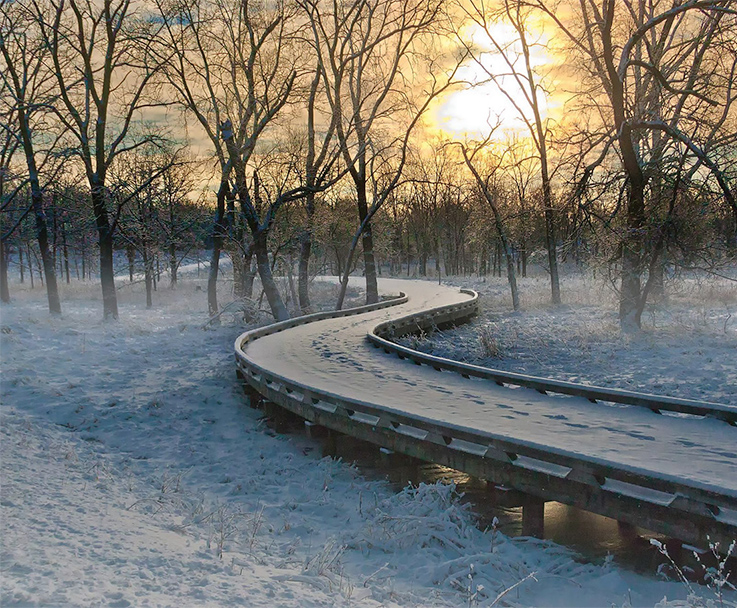
Boardwalk trail in Grassy Lake Forest Preserve.
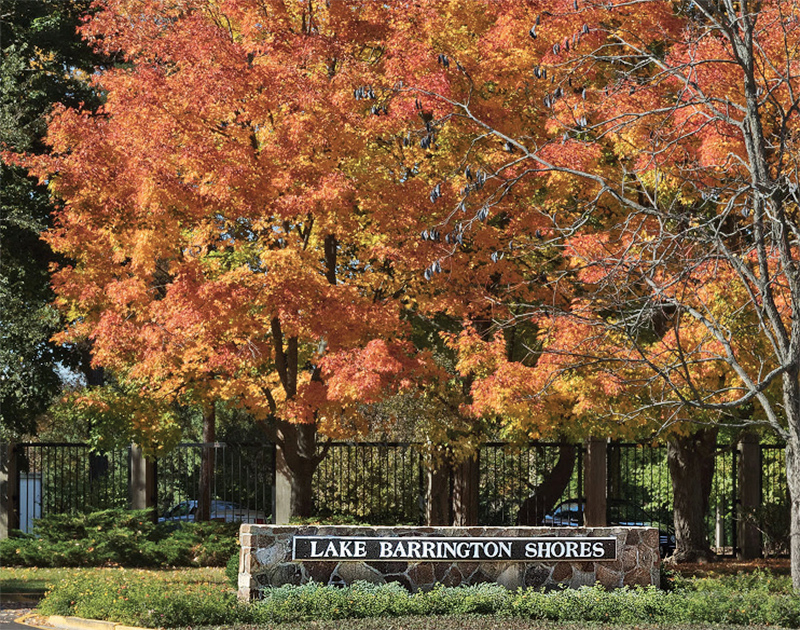
Lake Barrington Shores is a premier gated condominium community for families nestled in the countryside of the Village of Lake Barrington. LBS offers resort-style living with a private golf course, pools, tennis courts, and more.
Lake Barrington Shores
In 1946, the Criswell property, totaling 600 acres, was sold to Robert Bartlett, who paid $500 an acre for it. Born on a farm in Texas, he came to Chicago early in the century to become a successful real estate developer. His stewards on the Cuba property were experienced old timers who knew the land. They raised Angus cattle, sheep, and deer which were exchanged with neighboring villages and parks. The property was a haven for wild duck. Bartlett thought that there were too many Indian lakes across the country and changed the name to Barrington Lake. It was also suggested that the astute developer preferred the prestige of the Barrington name.
The sale to Bartlett was not the trend after the Second World War, when people were leaving the cities with deteriorating housing and infrastructures, seeking suburban areas and beyond, for affordable housing and safe environments on smaller lots. Improved highways gave access to rural areas where lifestyles were changing. The loss of youth in wartime, and the demand for higher education, meant that generational farming was becoming unviable.
In western Cuba Township, closer to the Fox River, there were already smaller residential tracts like Kelsey Grove, now Shady Hill. However, the area was still dominated by farming landowners. Max Hurd had reduced his acreage, but he enjoyed a spectacular view from his residence on the second highest point in Lake County. James McGraw maintained over 600 acres, and Quaker Oats assembled over 400 acres in grains to support their animal feed testing kennels. These parcels would stand late into the 20th century.
There were some newcomers to the rural life. Dr. Carl and Dr. Lucile Schleifer moved from Park Ridge in 1953 to property north on River Road. Their children, Carol, Roberta, and Carl C. were raised with sheep, a pony, chickens, rabbits, several dogs, and a plethora of cats. The family owned and managed Tanglewood Mink Farm. The children enjoyed 4-H and scouting. Their parents were active in civic affairs leading to Lake Barrington’s incorporation in 1959. Lucille was a founding board member and the first female trustee of the village. Roberta followed her parents’ footsteps; the civic welfare of her community, and its history very important to her. In fact, Lake Barrington has been fortunate in the generosity and attachment of many residents to its well-being.
The 1950s needed dedicated residents to safeguard their rural inheritance. The Lake County Board was holding zoning and land-use hearings, as developers’ petitions poured in from all over the county. The County’s original zoning was for one-half acre lots in areas it controlled. Many farmers, eager to retire, including in Cuba Township, looked to profit from sales to developers, and objected to the 5-acre zoning proposals being advocated by other residents’ groups. Even Robert Bartlett had long-range plans to develop his property. He joined Jorgen Hubschman and Ray Tucker as they worked for the lower zoning standards. Meanwhile, other areas around the Village of Barrington were incorporated in 1957 and positioned to begin annexations beyond their initial boundaries. Most of Cuba Township was fair game. By co-incidental referendum, the “twin villages” of North Barrington and Lake Barrington were both incorporated on October 31, 1959.
Boundary and zoning issues continued, especially after Robert Bartlett died in 1967, when his heirs negotiated sale of his estate with the James Companies and Standard Oil of Indiana, presaging a high-density development. But as the Village of Lake Barrington grew, it offered diverse living environments, in new subdivisions with minimum one-acre zoning, sited between nature preserves, a golf course, a flowing creek, and a historic river. That at-first less than welcome townhouse community matured where once Bartlett’s cattle and deer grazed. A commercial section sheltered off of Northwest Highway, and a first-class hospital overlooking its own lake, with a restored savanna to the south, and Forest Preserves to the north, added to the village amenities.
As I have recaptured some of Lake Barrington’s past, it is time to turn the story over to Village Mayor Kevin Richardson for his observations about the community today, and his thoughts for the future.
- Sidebar -
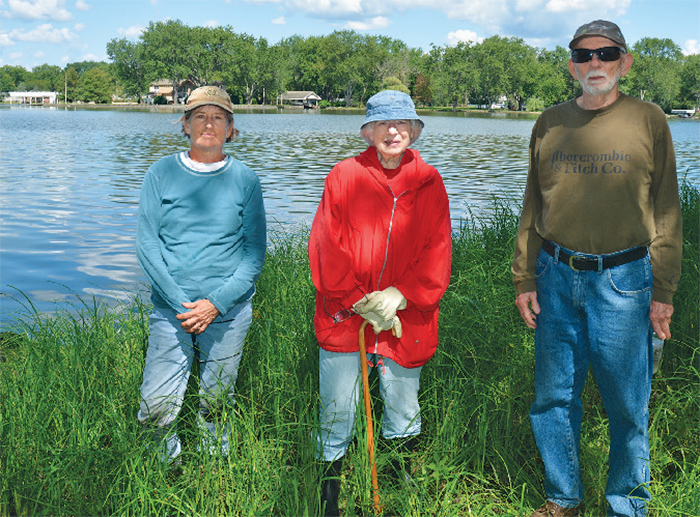
On August 6, 2020, Grassy Lake Site Stewards Carol Hogan and Wesley Wolf directed Barbara Benson through the thick woods and brush to a destination on the Fox River at a departure point off the Grassy Lake Flint Creek Trail. The goal was to find where the first settlers in Cuba Township, Joseph Flint and his son, Amos, had built their log house; it was at this point where the apt-named Flint Creek flows into the Fox River. Hogan and Wesley earned national recognition for their work shortly after this back-in-time adventure.
Where It Began: “Amos Point”
A Tribute by Barbara L Benson
The words kept calling me: “Their log house had burned during the first winter, leaving them in a pitiable condition.” Somewhere here in Lake Barrington, where Flint Creek flows into the Fox River, a few brave people had settled.
There was nothing but wilderness; no one to call, no resources but their own determination and courage. Such were the circumstances when the first settlers from the East entered Cuba Township in 1834.
How to find this place? I had an idea. I called longtime Grassy Lake Forest Preserve volunteers and stewards, Carol Hogan and Wesley Wolf. They responded with enthusiasm, and soon went to reconnoiter along the Flint Creek trail. Wesley had studied some aerial maps. Through the wilderness they reached the Fox River at the outlet of Flint Creek. They volunteered to take us there.
On Thursday, August 6, 2020, QB editor Lisa Stamos and I, together with Wes and Carol, stepped off the beaten path into a sea of native sedges and invasive reed canary grass. Soon, there was a dense canopy of old buckthorn, shutting out any wildflower growth, and a few deer trails. Then, the waters of the Fox glistened up ahead. We emerged to find the Fox lapping on a narrow, sandy beach. South along the beach is where Flint Creek flows into the river. We were close. Wes believes those aerial maps reveal that erosion may have submerged any remains of Amos Flint’s cabin.
Amos died about two years after arriving. He is probably buried around here. Rejoining the trail, I am glad to have saluted his spirit and those of his fellow travelers of 186 years ago.
- Sidebar -
Lake County Forest Preserves Recognized with Three National Awards
Carol Hogan and Wesley Wolf Earn Outstanding Volunteer Award
The National Association of County Park and Recreation Officials (NACPRO) is a nonprofit organization with park and recreation member districts across the nation. There are four members from Illinois, including Lake County Forest Preserves, which earned a Planning Initiative Award for Lakewood Forest Preserve in Wauconda. The county’s charitable partner, Preservation Foundation, was recognized with the Outstanding Organization Award for its impact via major donations to benefit parks and recreation programs. Site Stewards Carol Hogan and Wesley Wolf, who have together contributed nearly 14,000 hours at Grassy Lake Forest Preserves, earned the Outstanding Volunteer Award for their dedication and service.
Together, Hogan and Wolf have been volunteering since 2006 for a variety of projects and public service in the Grassy Lake Forest Preserves area of Lake County, as well as at Lake Barrington Shores. Much of their hard work includes cutting down invasive brush and collecting and sowing seeds of beneficial native prairie plants. They volunteer for the Barrington Greenway Initiative which is an expansive public and private collection of adjacent land spaces being restored and protected as a wildlife corridor. Visitors to Grassy Lake Flint Creek location often learn about preservation efforts while talking with Hogan and Wolf who share their passion for nature and the importance of conservation.
Lake Barrington’s pristine environment has long made it “an oasis of gracious countryside living”. With beautiful, publicly accessible forested areas and walking trails that are complemented by picturesque wetlands, waterways, and golf courses—our community blends the best of residential living with premier schools, shopping, and restaurants.
Our residents have convenient access to downtown Chicago, neighboring communities, and O’Hare International Airport through two nearby train stations and a major interstate. Whether you spend an afternoon hiking, visiting our shops and restaurants in Pepper Park or at the Market Place Shopping Center, or simply spend time outdoors with neighbors and friends, Lake Barrington offers an excellent place to live, raise a family, and run a business.
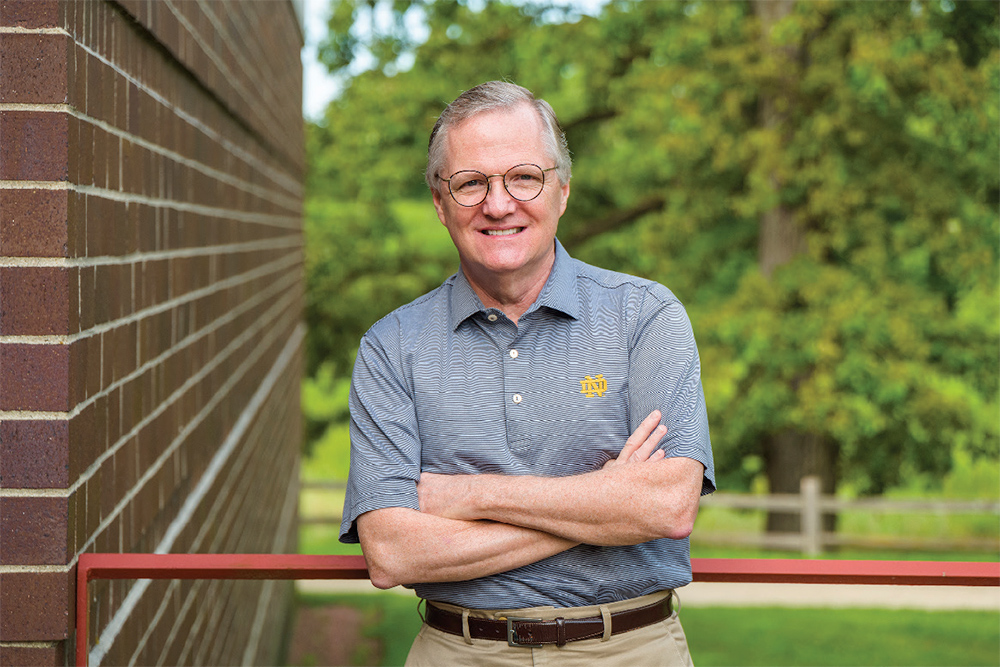
Mayor Kevin Richardson
Lake Barrington Today and Tomorrow
A Letter from Mayor Keith Richardson
Lake Barrington’s pristine environment has long made it “an oasis of gracious countryside living”. With beautiful, publicly accessible forested areas and walking trails that are complemented by picturesque wetlands, waterways, and golf courses—our community blends the best of residential living with premier schools, shopping, and restaurants.
Our residents have convenient access to downtown Chicago, neighboring communities, and O’Hare International Airport through two nearby train stations and a major interstate. Whether you spend an afternoon hiking, visiting our shops and restaurants in Pepper Park or at the Market Place Shopping Center, or simply spend time outdoors with neighbors and friends, Lake Barrington offers an excellent place to live, raise a family, and run a business.
Building a Welcoming Community
I am proud of the steadfast resilience and the caring generosity that our residents have shown during the COVID-19 pandemic. Through numerous acts of individual kindness and their loyal support of our local businesses, our residents have stepped up to provide a helping hand.
Once we are able to join together again, we will enthusiastically restart events like our annual Barn Stomp and the Music Nights at Freier Farm that we began last summer. We value the opportunity to host events that enable our residents to enjoy Lake Barrington’s beautiful environment in the company of family, neighbors, and friends. While events for this year had to be canceled because of COVID-19, there is no doubt they will return in the future.
Prioritizing Open Space and the Environment
Publicly accessible open space is what makes our community unique and it is why so many families (including my own) have chosen to make Lake Barrington home. Our prize property is the 24-acre Freier Farm, which includes a community garden, a brick fire pit, horseshoes and bean bag toss facilities, walking trails, and a winter sledding hill. Across the street, the full creation of Fetherling Park on Kelsey Road has been delayed due to the financial impacts of COVID-19 but, once completed, will add an additional 8.1 acres of open space in the heart of our community.
The purchase of these properties is part of a larger strategic plan established 15 years ago that is focused on protecting and enhancing Lake Barrington’s natural environment and groundwater recharge areas. This plan has guided Village efforts on a number of issues, including the direct purchase of open space that has enabled us to expand the amount and quality of outdoor space that our residents can use and enjoy.
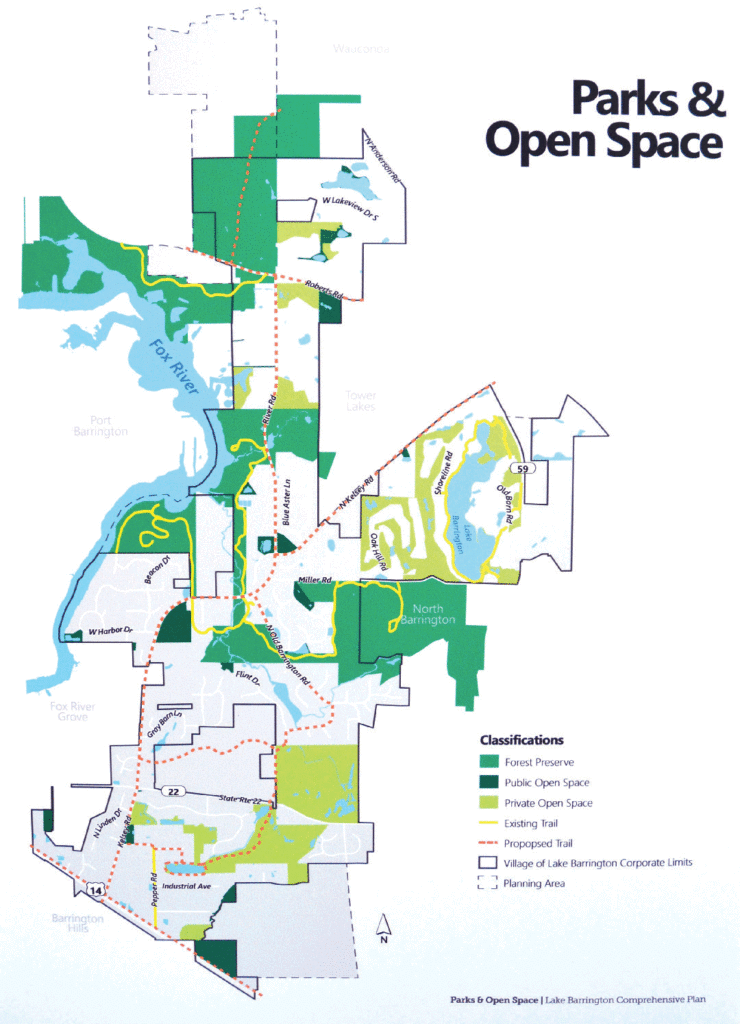
Enhancing the Environment
Our plan has also guided our work with the Lake County Forest Preserves District (LCFPD) and with Citizens for Conservation (CFC) on land use policies and financial partnerships and has enabled both LCFPD and CFC to advance conservation initiatives of their own within Lake Barrington that are compatible with our strategic plan. These partnerships have leveraged our community’s open space investment dollars and enhanced our environment.
Another example of our strategic plan resulting in long-term benefit occurred nearly two decades ago when Lake Barrington led efforts to negotiate an intergovernmental agreement with the Village of Wauconda, Cuba Township, and the Illinois Sierra Club to assure that the then-proposed expansion of Wauconda’s waste water treatment plant would operate under higher treatment standards than those typically required by the State of Illinois. This effort has not only protected the groundwater in the northern part of our community for years, it became a negotiating model for other communities to follow as it made the Illinois Sierra Club a legal party to the agreement and underscored Lake Barrington’s commitment to the environment.
Similarly, our tree preservation ordinance, passed in 2006, has assured that the magnificent trees that define our community enjoy protection under Village law.
Preservation Strategies
Last year, Lake Barrington engaged in a “Healthy Hedges” initiative which removed buckthorn trees on public property and replaced them with 64 new native trees and shrubs. While the primary focus of the project was to improve public spaces, it also provided residents with the opportunity to learn more about the process so it could be carried out on private property as well.
Attention to the environmental priorities and community aesthetics take shape in other ways as well. For example, the design specifications for Lake Barrington’s Speedway Café and Service Station were the result of very thoughtful deliberation by the Village’s Plan Commission and Board of Trustees and resulted in an approach that has become a national model for the aesthetic design of such facilities.
We take pride in the fact that so much of what we enjoy in Lake Barrington today is because of our community’s vision and the successful strategy we created 15 years ago to advance it.
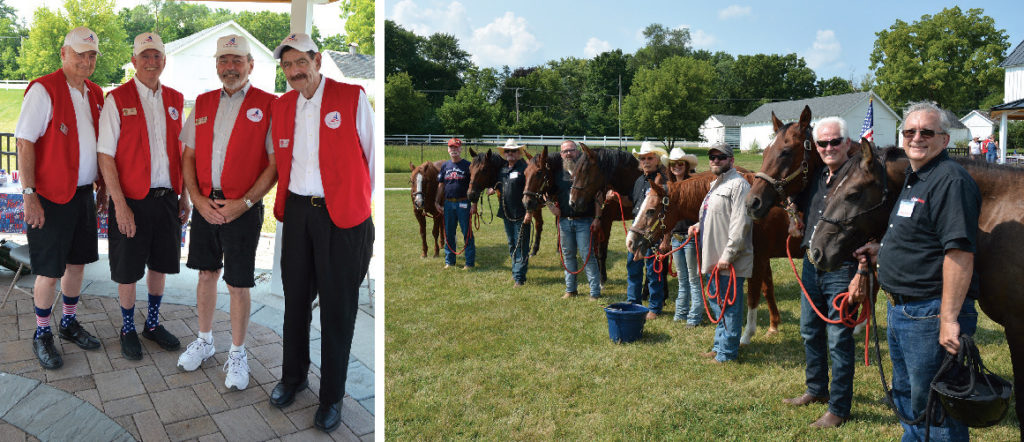
Left: Members of the Veterans of Lake Barrington Shores attended the 2018 BraveHearts event. Right: Equine-assisted therapy experts BraveHearts along with the Veterans of Lake Barrington Shores hosted an event at Freier Farm in 2018 to educate the public on their capabilities.
Creating a Strong Economic Future
Lake Barrington operates under the premise that residential property tax funds are not the Village’s money but, rather, the residents’ money. For this reason, the Board of Trustees has always sought to keep residential property taxes and other locally controlled costs for residents as low as possible while developing revenue sources that take the pressure off residential property taxes.
In order to maintain the services that our residents have come to rely on, Lake Barrington continuously works to foster thoughtful growth consistent with the values and priorities of the community. I am pleased to report that over the past several years, many businesses have opened up in or relocated to Lake Barrington, offering new services and amenities to our residents. Each of these businesses are consistent with our “oasis of gracious countryside living” mission and we welcome them all to our business community.
Recent additions include All American Reclaim, which opened its doors last summer and provides residents and businesses with a premier selection of reclaimed wood, antiques, and décor. This follows the highly successful December 2017 opening of Speedway and the opening of both DiBi, a contemporary men’s fashion and accessories company, and Lake Barrington Motorsports, which specializes in the maintenance of luxury European cars and classic car repair.
The Village recognizes that those who invest in our community have choices and we work hard to provide a positive business climate. This year, we digitized the business licensing process and placed it online so that it would be easier for companies to do business with the Village. We also temporarily suspended business license and other fees to help our businesses manage through the economic challenges presented by the COVID-19 pandemic.
Support for Veterans
With more than 35,000 veterans in Lake County, the Village of Lake Barrington is proud of its work to support those who serve or have served our nation. This can be seen through the work of the Veterans of Lake Barrington Shores, who completed a successful partnership with BraveHearts, a therapeutic horseback riding center, to educate the public about the benefits of equine therapy.
Through this interactive initiative, residents and guests from surrounding communities were able to learn how equine-assisted therapy can help service men and women as well as veterans who face a variety of health challenges. We are proud that this initiative was recognized in 2019 with a Governor’s Hometown Award in the category of Veterans and Military Families.
Lake Barrington is a beautiful community committed to being an “oasis of gracious countryside living”. We work hard to serve both our residents and our businesses which provide valuable amenities to the people of Lake Barrington. Our community follows a well-established plan that has been—and remains—focused on assuring that our unique environment will be here for generations to come.
Come visit Lake Barrington in person or get to know us through Facebook or online at
www.lakebarrington.org. The “Welcome Mat” is always out!
- Sidebar -
Mayor Kevin Richardson
Married for 32 years to Lynne Jolly Richardson:
- Two adult daughters, Mary Ellen and Charlotte.
- Both daughters live in Washington, D.C.
- Two cats, Pip and Darcy.
Lake Barrington governmental service:
- Village Trustee (1999-2005).
- Mayor (2005 to present).
Professional:
- President of Heartland Solutions Group, Inc., Chicago (2006 to present).
- Senior Vice President of Government Affairs, The ServiceMaster Company, Chicago (2002-2006).
- Vice President of Government Relations, RR Donnelley, Chicago (1996-2002).
- Vice President of Government Relations, Electronic Industries Association, Washington, D.C. (1987-1996).
- Associate Counsel, Committee on the Judiciary, U.S. House of Representatives, Washington, D.C. (1984-1987).
- Assistant PAC Director, National Republican Congressional Committee, Washington, D.C. (1983-1984).
Civic:
- Board of Visitors, Graduate School of Public Policy, Pepperdine University (2007 to present).
- Advisory Board, Institute for Latino Studies, University of Notre Dame (2009-2013).
- Political Advocacy Committee, US Chamber of Commerce, Washington, DC (2007 to present).
- Mayors Water Council, US Conference of Mayors, Washington, DC (2007 to present).
Education:
- J.D., Pepperdine University School of Law (1982)
- B.A., Economics, University of Notre Dame (1979)
– End –
Share this Story

